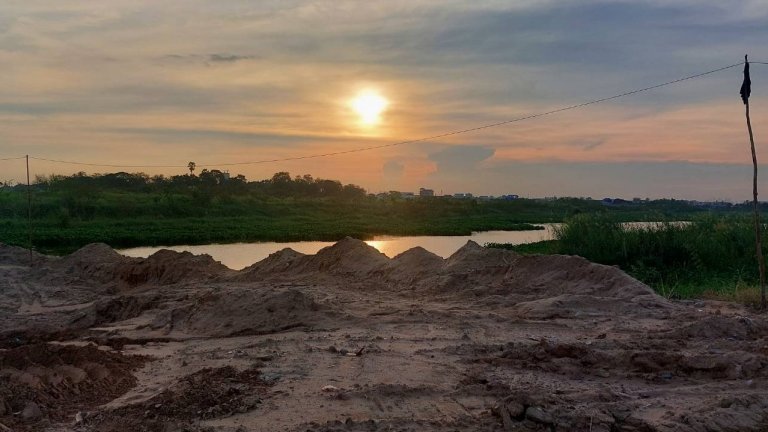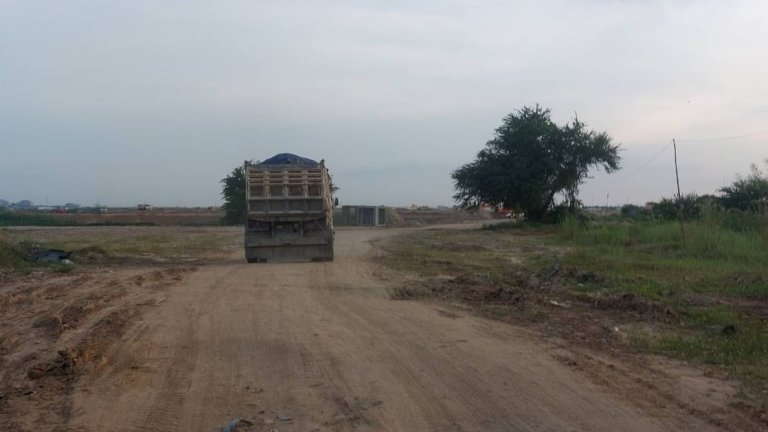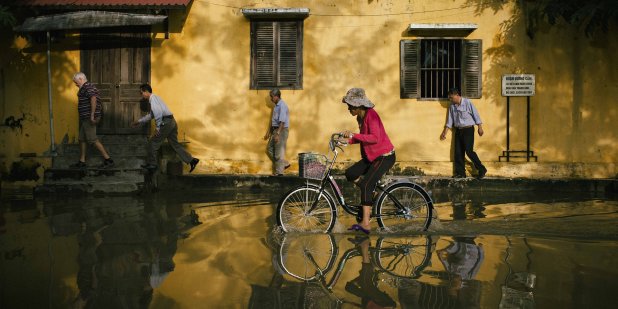- About
- Topics
- Picks
- Audio
- Story
- In-Depth
- Opinion
- News
- Donate
-
Signup for our newsletterOur Editors' Best Picks.Send
Read, Debate: Engage.
Lake fillings by developers are linked to the forced displacement of a growing number of Phnom Penh residents and the capital's increased susceptibility to flooding.

© Danielle Keeton-Olsen
Growing up, Kep Phirum said her family did not want for fresh food, as their 13 or 14 hectares of land outside the Cambodian capital provided rice on the dry land and fish, snails and water-grown vegetables in the wetlands - a by-product of the confluence of the arterial rivers that make Phnom Penh a natural capital for the country.
"In the past we didn’t spend any money, we just lived our lives very simply," said 40-year-old Phirum, now a fruit vendor in Phnom Penh. "We didn’t have to spend much because it was before everything needed to be updated, to get this and get that."
Though she was referring to Cambodia’s development and the growth of consumer culture, Phirum land was "updated" as well: the area was marked in Kandal province outside Phnom Penh when they received land titles in 1991, but has since been incorporated into the expanding city, where land prices have skyrocketed.
Last year, officials confiscated land from Phirum and 37 other families to pave way for a proposed drainage reservoir. Phirum told FairPlanet that local officials told her to demarcate her land with posts at her own expense before the eviction, adding yet another cost for her family. "After that, the government took it and said it was their land, so we can’t say anything," she added.
As a developing nation, Cambodia is considered by COP27 parties to be among the countries most vulnerable to increasingly severe flooding and droughts as the earth warms from global emissions. The country receives funding from various bodies promoting climate-resilience as a result.
But Phnom Penh’s urban residents, particularly the struggling working class, are hit simultaneously by the effects of climate change and the impacts of a rapidly changing city with little charted urban planning.
At this year’s COP27 in Egypt, developing nations are making a renewed call to the world’s economic superpowers to create a new climate fund to compensate loss and damage for both sudden and long-term environmental destruction. Their demand comes as nations struggle to make sufficient adjustments to keep atmospheric temperature change in the next century as close as possible to 1.5 degrees Celsius.
During the last global climate conference in Glasgow, Cambodia announced a plan to reach net-zero emissions by 2050, which is heavily reliant on reducing deforestation and encouraging carbon-capture projects. All the while, environmental activists and journalists are decrying widespread logging and development projects in the nation’s largest lowland evergreen forest.
The UN resident coordinator in Cambodia commended the effort, but noted that the country "will need to strike a balance between mitigation actions in the strategy" to ensure that the most vulnerable populations, who are most impacted by climate change, are not forgotten.
After Cambodia released a nationally-determined contribution update to the United Nations Framework Convention on Climate Change (UNFCCC) this year, one analyst noted that it was sparse on details of Cambodia’s adaptation plans to Loss and Damage, especially in comparison to other Southeast Asian nations.
"The government took it and said it was their land, so we can’t say anything."
But while making plans to match the global climate agenda, Cambodia is following a different trajectory at home, which is costing residents their houses in the short term and is expected to strain the city further in the future.
In Cambodia’s monsoon season, which generally ranges from May to November but is becoming harder to chart, Phnom Penh's streets flood, trash disperses from roadside piles and rivers and traffic clogs.
Prime Minister Hun Sen claimed heavy rainfalls in October 2020 were the main cause of flooding in the Cambodian capital, classifying it as a "natural disaster" and trying to deflect concerns about the filling of Phnom Penh’s lakes for new development projects.
By November 2021, Hun Sen said the government’s lake-filling developments caused minimal harm in the past, and so filling more wetlands would hold no consequences.
"What I hate the most is every time there is a flood, they curse and curse that we wipe away the lake," he said in a speech at the time. "Do you understand the word flood?"
From north to south, developers are filling lakes and wetlands in Phnom Penh as the cost of land appreciates, rising to USD $300-$500 per square metre in even some farther districts according to reports from a local real estate web portal.
A large part of this land-creation campaign involves official approval: much of the Boeng Tompun and Boeng Choeng Ek lakes in Phnom Penh’s southern reaches were filled and slowly transformed into the ING satellite city after it was granted to the company by the government almost two decades ago. At the same time, Boeng Tamok, a natural lake in the north, has been steadily parceled off in government decrees to officials, government bodies and private institutions despite consistent protests by residents.
These cityscape changes have made headlines locally, and sometimes internationally, as they are predicated on residents like Phirum loing their land.
While Cambodia is hosting this year’s ASEAN Summit as the regional bloc’s temporary chair, residents of Boeng Tamok lake held a protest in which they cursed officials and companies that are kicking them off shorelines they say they’ve lived on for decades.

© Danielle Keeton-Olsen
Officials have sought to suppress such protests.
Phirum said that she and the other 37 families had staged a protest in 2021 after officials kicked them out of their homes to build a reservoir to support the developing Boeng Tompun area, but they were met with massive forces. She estimates 100 or 200 guards showed up to stop them, when there were only 80 protesters present.
In addition to the protests, local NGOs have pointed out the potential for future damage: a 2020 report noted that the southern Tompun-Choeng Ek wetlands would be reduced from 1,500 hectares to just 107 hectares if all development plans go through.
However, a 2018 study commissioned by the Phnom Penh City Hall warns that the city needs to maintain almost 500 hectares of wetlands in order to prevent flood and wastewater issues, which the city is apparently trying to tackle.
But although Phnom Penh’s evictions can make headlines as they happen, attention tends to fade from older eviction campaigns as developers transform lakes into condos and shopping plazas.
In the late 2000s, more than 3,000 people were forced out of their houses, often violently, from the centrally-located Boeng Kak lake, and as the case made international headlines, the World Bank investigated its financing of the lake-filling project and decided to freeze its funding in Cambodia in 2011. That moratorium was ultimately lifted in 2016, though land activists said there had not been significant improvements on human rights and transparency in development projects.
Since then, at least one recent contemporary lake-filling development in the Tompun-Choeng Ek wetlands has received environmental approval as well: the Japan-listed Aeon Mall development project in Phnom Penh’s Meanchey district received preliminary sustainability certification for its energy efficient light bulbs, air conditioning and water systems.
Harri Hudson, a PhD candidate at Royal Holloway University in the UK, said he is currently researching the environmental and labour impacts on remaining residents in the Tompun-Choeng Ek wetlands. Hudson has found residents to be undergoing pressure to find new work apart from farming and fishing in the wetland, as well as relocate their homes.
The residents of regions like Prek Takong within the Boeng Tompun area are now "effectively downstream" of newly-built roads and structures on the filled land, which makes them susceptible to increased flooding, he told FairPlanet. "This is at the same time that they’re being pushed out or pressured by local authorities to relocate forcefully."
He added that various organisations, from grassroots NGOs to the UN, have criticised such developments, but have led to few on-the-ground changes.
After serving as a youth representative at COP26, Hudson said he felt discouraged by such actions, remarking: "I don’t think that COP can even hold developed countries accountable to anything."
"We can condemn this, but I feel like NGOs on the ground have condemned it already and it’s not changed anything, because the status quo is what it is," he said.
Additional reporting by Klaing Kimhuoy
Image by Danielle Keeton-Olsen.
